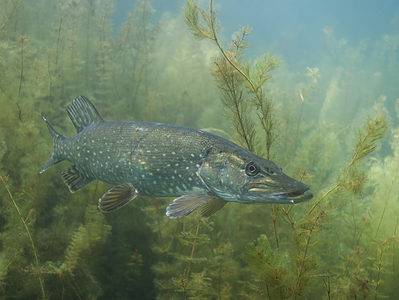Below you can find a complete list of Swiss animals. We currently track 249 animals in Switzerland and are adding more every day!
Animals that are built to navigate rocky terrain, colder climates, and high altitudes can be seen across the mountainous country of Switzerland. Notably, the Alpine ibex, chamois, mountain hare, golden eagle, and Alpine marmot.
Once extinct in Switzerland, the unique mountain goat referred to as the Alpine ibex was reintroduced from Italy at the beginning of the 20th century. They are now found in abundance throughout the Swiss Alps, preferring rocky habitats far away from any predators.
The Official National Animal Of Switzerland
Switzerland is one of the few countries that does not have an official national animal. In Swiss culture, cows are important though they have never been declared the national animal on an official level. Similarly, the blackbird is another popular animal with no real claim to the official title.
While each of the 26 Swiss member states has its own coat of arms, on which heraldic animals can be seen, unique is the country itself in its lack of a national flower and official national motto.
Where to Find The Top Wild Animals In Switzerland
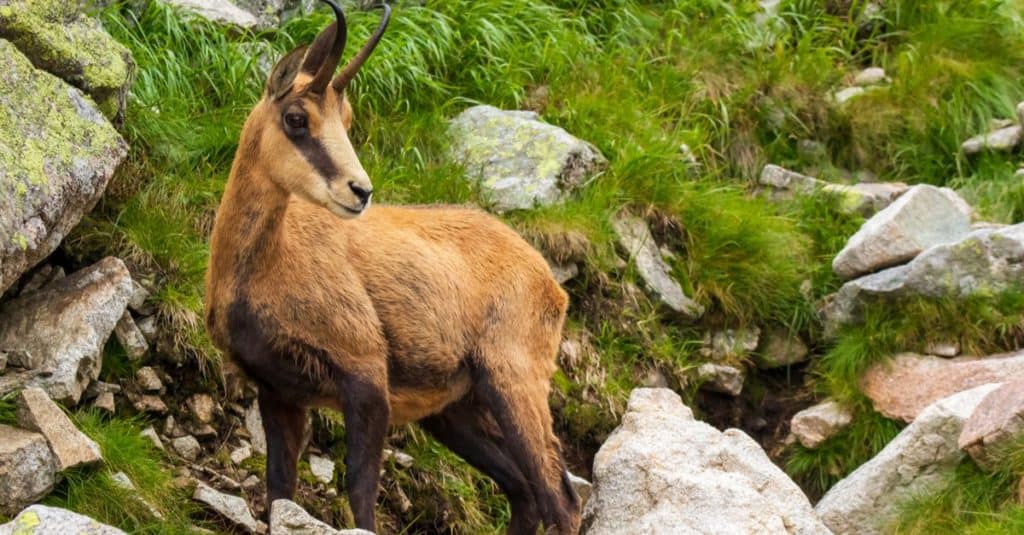
The chamois is an impressive Swiss goat-antelope that can be found in high altitudes of the Swiss Alps.
©Michal Blaho/Shutterstock.com
- Chamois – This impressive Swiss goat-antelope is one of the few large animals that never became extinct. Excellent rock climbers, these resilient creatures are found in the Alps at high altitudes, choosing to descend occasionally to feed.
- Mountain Hare – One species of the hare that has adapted to multiple habitats, they can be found in both mountainous and polar regions. Though they are found across national parks, it is harder to spot these creatures compared to other wildlife as their white coats blend seamlessly with the Swiss snow. As a result of tourism-based development, mountain hares are now settling in plains and forests, a far reach from their natural habitats.
- Red Deer – The largest-hooved wild animal in Switzerland can be found in the Swiss Alps and across many national parks. Once extinct in the country, as well, a hunting ban from the 1800s has led to renewed population growth in the species.
- European Mole – These Swiss natives are found all across Europe and prefer habitats with deep soil that allows them to tunnel across woodlands and other similar regions.
- Barn Owl – This unique bird is one of the most widespread animals on the entire planet. Polar and desert regions, pacific islands, and Indonesia are the only places in the world that this owl cannot be found. They are found in Swiss woodlands where they hunt for small rodents and can travel about 900 miles across Europe when they please.
- Alpine Marmot – A member of the squirrel family, this species is found in the higher elevations of the Swiss Alps. As excellent diggers, they make their home in burrows which serve as a great location to hibernate for the winter. Often seen following the paths of humans along the mountainside, their comfort with people has become so strong that they have been known to wander into homes on the Alps.
- Brown Bear – The highest chance of seeing a brown bear in Switzerland occurs near the Italian and Austrian borders, as there are only a few in the country itself. These bears are making a comeback in the Western European nation as they continue to migrate from Italy but seem to have a long road ahead of them yet.
The Most Dangerous Animals In Switzerland Today
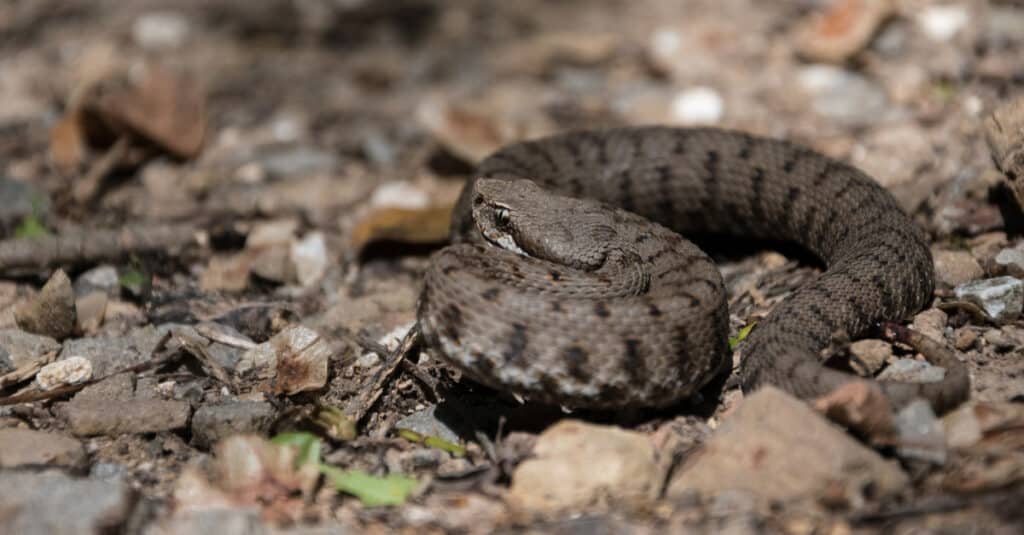
The asp viper (Vipera aspis francisciredi) is the most dangerous animal inhabiting Switzerland.
©Claudio Pardo/Shutterstock.com
The most dangerous animal in Switzerland today is the aspic viper (also known as asp viper, asp, European asp, European viper, or Jura viper.)
This snake can be found in nearly any of Switzerland’s regions, due to its ability to exist at high altitudes, in mountainous and hilly regions, forests, meadows, and most woodlands areas.
Recognizable by their distinctly short tail and broad, triangular head, there are various dorsal markings that one might notice on this species. At around 25 inches (60-65 cm) their bite can be extremely painful and, if untreated, result in death in nearly 4% of cases. Paralysis of bitten limbs, difficulty breathing, and vision issues are just a few results of this bite.
Endangered Animals in Switzerland
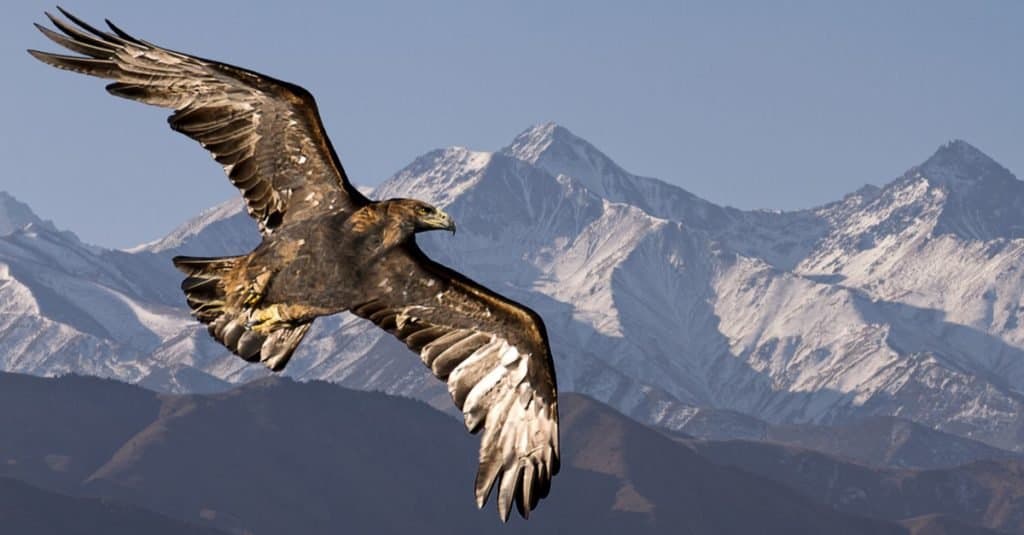
The golden eagle is an endangered animal in the country of Switzerland.
©MehmetO/Shutterstock.com
Switzerland, like much of the rest of Europe, lost a significant portion of its wildlife between the 1600s and 1800s. Thanks to rehabilitation programs and conservation policies, many animals that were once extinct in the country have been reintroduced, while some have naturally reentered Switzerland.
However, unfortunately, this does not mean that there exists a lack of endangered species.
Brown bears were hunted to extinction in the country in 1904 and were not reintroduced successfully until the early 2000s. In just 2017, the first wild brown bear migrated to the Swiss countryside from Italy, but this species remains endangered in Switzerland all the same.
Golden eagles, commonly referred to as the “king of the air” are grand creatures with a wingspan of six feet. They also were once on the verge of total extinction, but now remain endangered with about 300 pairs located throughout the country.
The 7 Largest Swiss Animals
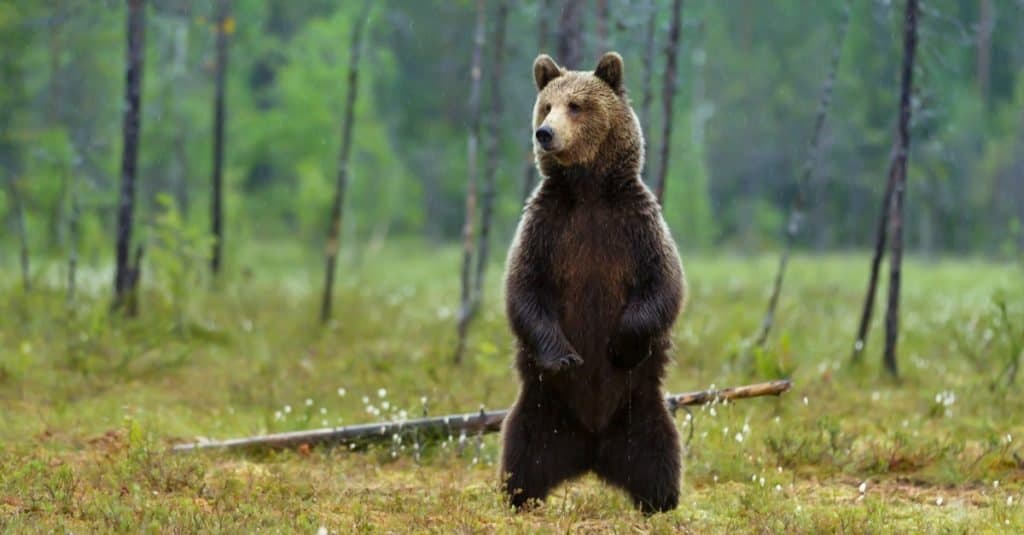
The Eurasian brown bear is the largest predator still living on the continent of Europe.
©Giedriius/Shutterstock.com
When looking for large wild animals in Germany, they really don’t compare in size to animals of other continents like Africa. But there are some animals that tip the scales, which we’ve listed below:
- European Bison: The rarest of European animals, it can be found in the western area of Switzerland. It weighs an average of 1,398 lbs for males and 935 lbs for females.
- Eurasian Brown Bear: These rare beasts can weigh up to 1,060 lbs and stand a bit over 8 feet tall.
- Red Deer: Red deer can grow up to 4 feet tall and weigh as much as 530 lbs.
- Wild Boar (Eurasian Wild Pig): This wild pig can stand as tall as 4 feet and weigh as much as 220 lbs. In Switzerland, they can be found in the Jura, the northern Swiss plateau, Ticino, and Valais.
- Gray Wolf: European gray wolves average up to 150 lbs and can reach heights of 33 inches. There are an estimated 30-35 in Switzerland.
- Alpine Ibex: This wild mountain goat species can weigh up to 258 lbs and reach a height of 40 inches.
- Chamois: This goat antelope can get up to 31 inches tall and weigh as much as 121 lbs.
The Flag of Switzerland

Swiss flag waving on a mountain peak in Switzerland.
©kavalenkava/Shutterstock.com
The flag of Switzerland is one of the most easily recognized flags in the world with its red background and white center cross. The flag itself is unique in that it is a perfect square rather than a rectangle which most flags use. In modern times the Swiss flag has become a symbol of peace.
The design came about in 1840, patterned after the white cross that was utilized by the Holy Roman Empire. Previous to 1889 when it was adopted as the flag for the country, the flag was the official flag of the Swiss army in 1848.
Swiss Animals

Admiral Butterfly
Stunningly beautiful wings

Ant
First evolved 100 million years ago!

Apennine Wolf
Wolves do not howl at the moon. They howl to communicate with other members of their pack.

Appenzeller Dog
Herding dog by nature!

Armyworm
They are so named because they "march" in armies of worms from one crop to another in search of food
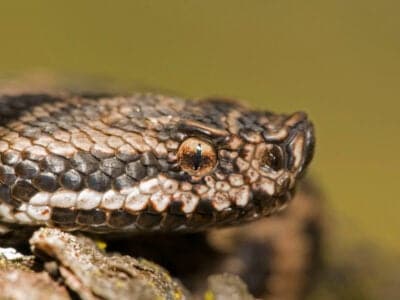
Asp
It was the symbol of royalty in Egypt, and its bite was used for the execution of criminals in Greco-Roman times.

Aurochs
Extinct ancestor of all domesticated cattle!

Avocet
Has a curved, upturned beak!
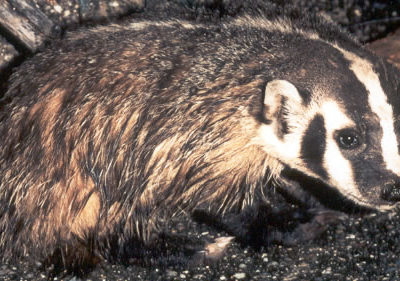
Badger
Can reach speeds of 30 km/h!

Barn Owl
Found everywhere around the world!

Barn Swallow
Older offspring help care for new hatchlings.

Bat
Detects prey using echolocation!
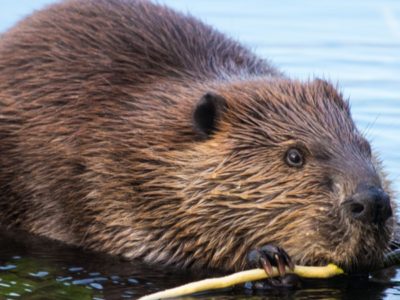
Beaver
Builds a dam from sticks and leaves!

Bed Bugs
Bed bugs feed for 4-12 minutes.

Bee
Rock paintings of bees date back 15,000 years

Beetle
There are more than 350,000 different species

Beewolf wasp
They hunt bees

Bernese Mountain Dog
Very loyal, faithful and affectionate!

Bird
Not all birds are able to fly!

Biscuit Beetle
The biscuit beetle form a symbiotic relationship with yeast

Black Widow Spider
They typically prey on insects!
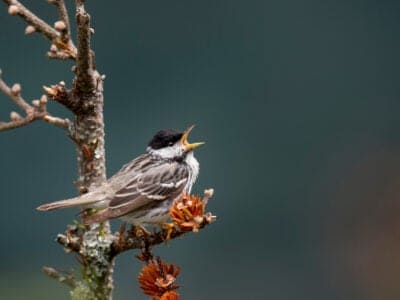
Blackpoll Warbler
They migrate for the longest distance of any warbler.
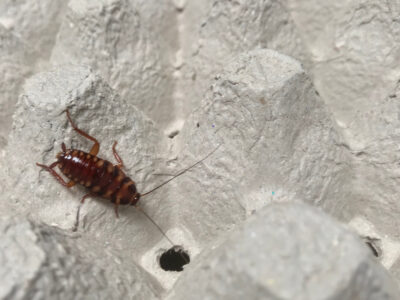
Brown-banded Cockroach
Females glue egg cases to furniture

Brown Dog Tick
Can live its entire life indoors

Bumblebee
The most common species of bee!

Butterfly
There are thought to be up 17,500 species!

Camel Cricket
The camel crickets that are found in the USA are light brown in color. They also have dark streaks all over their body.

Carpenter Ant
Carpenter ants can lift up to seven times their own weight with their teeth!

Cat
May have been domesticated up to 10,000 years ago.

Caterpillar
The larvae of a moth or butterfly!

Catfish
There are nearly 3,000 different species!

Centipede
There are about 3,000 documented species!

Chamois
Natively found in the European mountains!

Chicken
First domesticated more than 10,000 years ago!
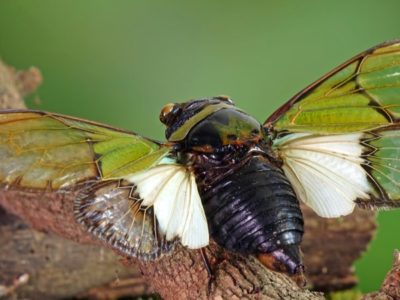
Cicada
Cicadas have one of the longest insect lifespans

Cockroach
Dated to be around 300 million years old!

Codling Moth
Pupae are able to undergo diapause to survive poor fruit yield years and winter.

Common Buzzard
The most common raptor in the UK!

Common European Adder
European adders are the only snake that lives above the Arctic Circle.
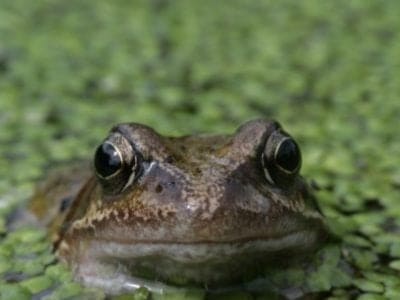
Common Frog
Found throughout the European continent!

Common Furniture Beetle
The common furniture beetle feeds exclusively on wood

Common House Spider
House spiders have the ability to eat most insects in a home.
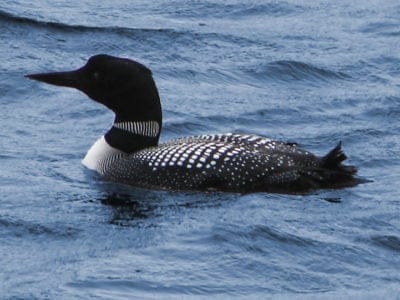
Common Loon
Also known as the Great Northern Diver

Common Raven
A group of ravens is called an unkindness or a conspiracy.

Common Toad
Most active in wet weather!

Cormorant
They can fly 35 mph and dive 150 feet below water.

Cow
There are nearly 1.5 billion worldwide!

Crab
There are 93 different crab groups

Crab Spider
Crab Spiders can mimic ants or bird droppings

Crane
Many are critically endangered species!

Cricket
Male crickets can produce sounds by rubbing their wings together

Crow
A group of these birds is called a Murder.

Deer
There are around 40 different species!
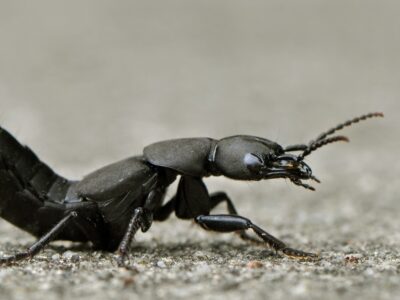
Devil’s Coach Horse Beetle
The Devil’s coach horse beetle can emit a noxious substance to deter predators

Dog
First domesticated in South-East Asia!

Dog Tick
Dog ticks feed on dogs and other mammals

Donkey
First domesticated 5,000 years ago!

Dragonfly
It's larvae are carnivorous!

Duck
Rows of tiny plates line their teeth!

Dung Beetle
The dung beetle can push objects many times its own weight

Eagle
Has exceptional eyesight!

Earthworm
They are hermaphrodites, which means they have male and female organs

Earwig
There are nearly 2,000 different species!

Edible Frog
Are known to guard the muddy banks!

Eel
Eels can be a mere few inches long to 13 feet!
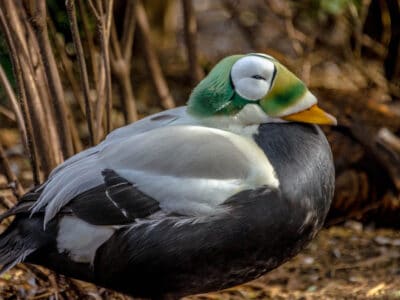
Eider
Eiders are sexually dimorphic, with males being larger and more colorful.

Entlebucher Mountain Dog
Native to parts of the Swiss Alps!

Ermine
A very bold and ferocious predator!
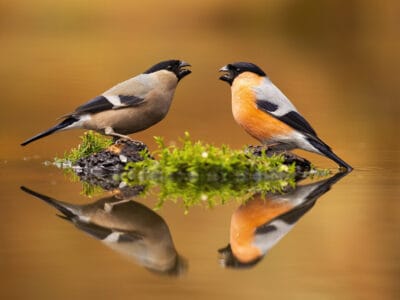
Eurasian Bullfinch
The shy eurasian bullfinch prefers to forage very close to cover.

Eurasian Eagle-owl
The Eurasian Eagle-owl is the second largest owl in the world with a wingspan up to six feet!
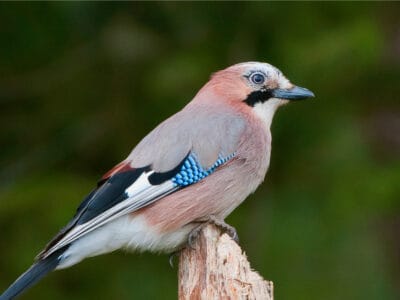
Eurasian Jay
The Eurasian jay has the ability to mimic other sounds
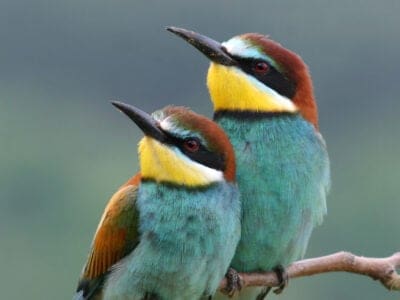
European Bee-Eater
They can eat up to 250 bees per day!
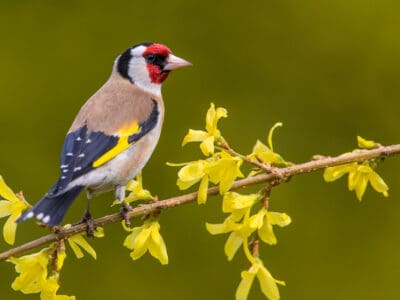
European Goldfinch
They are frequent visitors to backyard feeders, especially those containing niger seeds.

European Robin
Male robins are so aggressive and territorial that they will attack their own reflections.

Falcon
The fastest creatures on the planet!

Fallow deer
The fallow deer has more variation in its coat colors than most other deer.

False Widow Spider
False spiders actually prey on black widow spiders and other hazardous spiders
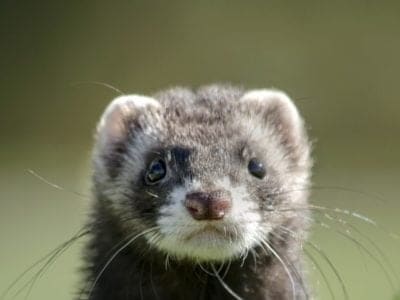
Ferret
Ferrets can be trained to do tricks like dogs!
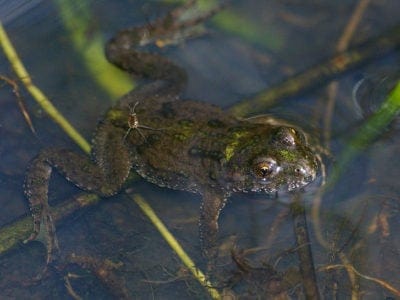
Fire-Bellied Toad
Found across mainland Europe and Asia!
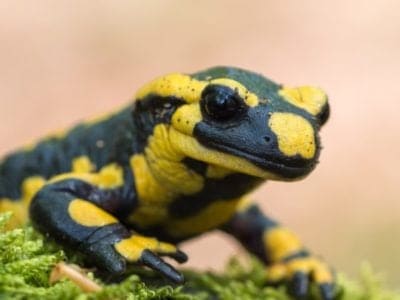
Fire Salamander
Its name comes from the fact that people once believed it was born in fire

Firefly
The firefly produces some of the most efficient light in the world

Flea
Adult fleas can jump up to 7 inches in the air
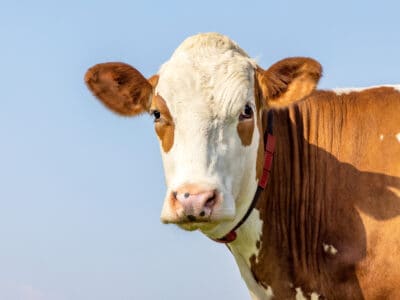
Fleckvieh Cattle
Besides being bred for milk and meat, these cattle were also used as draft oxen.

Fly
There are more than 240,000 different species!

Flying Squirrel
Can glide up to 90 meters!

Fox
Only 12 species are considered "true foxes"

Frog
There are around 7,000 different species!

Fruit Fly
Fruit flies are among the most common research animals in the world
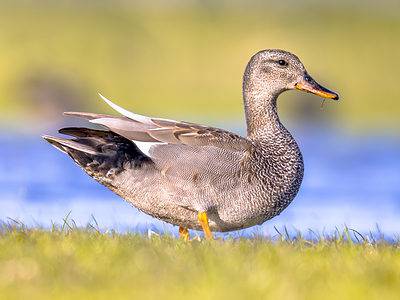
Gadwall
They make many sounds when trying to attract a mate.

German Cockroach
The most common type of urban roach

Glass Lizard
Can grow up to 4ft long!

Glowworm
Found inhabiting dense woodland and caves!

Gnat
Males form large mating swarms at dusk

Goat
Most closely related to the Sheep!

Goldcrest
The goldcrest never starts moving and needs to consume for most of the day to survive. Therefore, in the colder months, it's best that eat 90% a day.

Golden Eagle
Their calls sound like high-pitched screams, but they are quiet most of the time.

Golden Oriole
Migrates between Europe and Asia!

Goose
There are 29 different species!

Grasshopper
There are 11,000 known species!

Greater Swiss Mountain Dog
Protective and gentle by nature!

Gypsy Moth
One of the most invasive species in the world

Hamster
Able to run as quickly backwards as forwards!

Hare
Can reach speeds of over 50 mph!

Hawk Moth Caterpillar
Many hawk moth caterpillars eat toxins from plants, but don’t sequester them the way milkweed butterflies do. Most toxins are excreted.

Hedgehog
Thought to be one of the oldest mammals on Earth!

Heron
Inhabits wetlands around the world!

Highland Cattle
Natively found in the Scottish Highlands!

Honey Bee
There are only 8 recognized species!
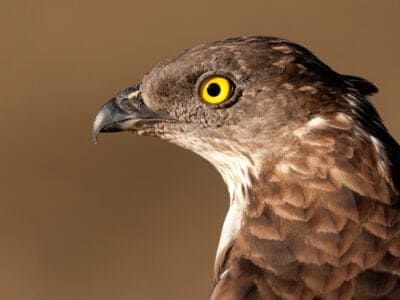
Honey Buzzard
Honey buzzards are medium-sized raptors that earned their names by raiding the nests of bees and wasps.

Hoopoe
Stunning bird with a stinky way to deter predators!

Horse
Has evolved over 50 million years!

Horsefly
Horseflies have been seen performing Immelmann turns, much like fighter jets.

Housefly
The fly has no teeth

Human
Thought to have orignated 200,000 years ago!

Huntsman Spider
Some huntsman spiders have an interesting way of moving around. Some cartwheel while others do handsprings or backflips.
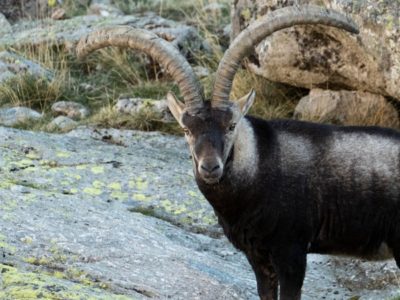
Ibex
Can jump over 6 feet straight up from a standstill

Insects
There are an estimated 30 million species!

Jackdaw
The jackdaw tends to mate for life with a single partner
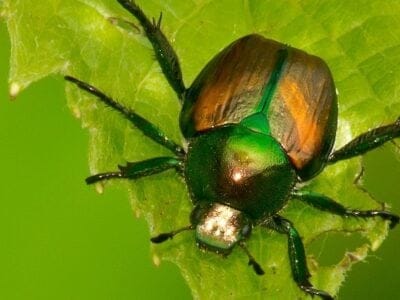
Japanese Beetle
Can clear an entire fruit tree in 15 minutes in a swarm

Jumping Spider
Some can jump 50 times the length of their bodies

Kingfisher
Inhabits wetlands and woodlands worldwide!

Ladybug
There are more than 5,000 species worldwide!
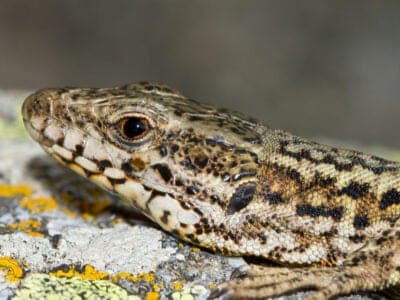
Lazarus Lizard
Lazarus Lizards can communicate through chemical and visual signals.

Leech
Has 10 pairs of eyes!

Lemming
Does not hibernate during the bitter Arctic winter!

Linnet
While linnets are monogamous during mating season, they do not mate for life. While breeding pairs are together, the males are highly territorial and will defend the nesting site and the surrounding area.

Lizard
There are around 5,000 different species!
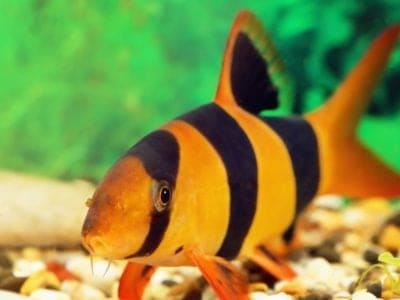
Loach
Have sharp spines below their eyes

Locust
Each locust can eat its weight in plants each day.

Long-Eared Owl
Ear tufts make it look bigger!
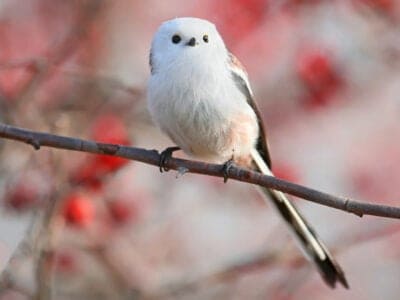
Long-Tailed Tit
Often hangs upside down while feeding!

Magpie
They are found across Europe, Asia and Africa!
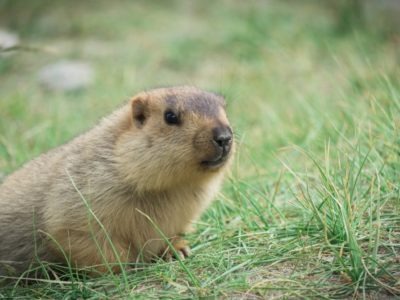
Marmot
A marmot spends 80% of its life below ground

Marsh Frog
Has bright green skin!

Mayfly
There are 2,500 known species worldwide!

Mealybug
They have a symbiotic relationship with ants.
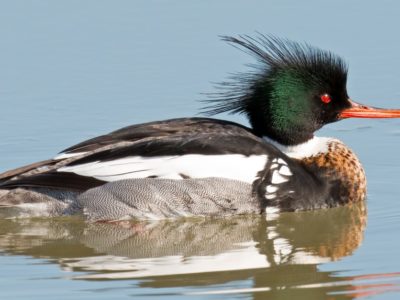
Merganser
They line their nests with their feathers

Millipede
Some species have a poisonous bite!

Mole
Primarily hunts and feeds on Earthworms!

Mole Cricket
Adult Mole crickets may fly as far as 5 miles during mating season and are active most of the year.

Mongrel
Has characteristics of two or more breeds!

Moorhen
Feeds on aquatic insects and water-spiders!

Mosquito
Only the female mosquito actually sucks blood

Moth
There are 250,000 different species!

Mouse
Found on every continent on Earth!

Mule
The offspring of a horse and donkey parents!

Natterjack
Can lay up to 7500 eggs

Neanderthal
Roamed Asia and Europe for around 100,000 years!

Nematode
Nematodes range in size from 1/10 of an inch to 28 feet long

Newt
Able to regrow lost or damaged limbs!

Nightingale
Named more than 1,000 years ago!

No See Ums
There are more than 5,000 species.

Northern Pintail
Northern pintails migrate at night with speeds reaching 48 miles per hour!
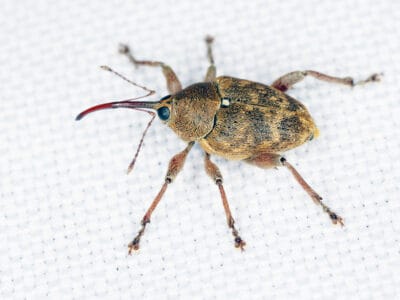
Nut Weevil
Bore holes in tree nuts and lay their eggs inside

Old House Borer
Depending on the habitat and climate, these beetles can live between 2 to 10 years, often staying in their larval stage for several years, making them extremely dangerous to wooden structures.

Orb Weaver
Females are about four times the size of males

Ortolan Bunting
The tradition of hiding your face with a napkin or towel while eating this bird was begun by a priest who was a friend of the great French gastronome Jean Anthelme Brillat-Savarin.

Osprey
They reuse nesting sites for 70 years!

Otter
There are 13 different species worldwide

Owl
The owl can rotate its head some 270 degrees
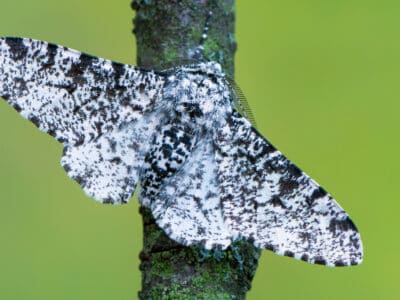
Peppered Moth
Teachers in schools often use the evolution of the peppered moth as a good example of Darwin’s theory of natural selection.

Peregrine Falcon
Fastest animal on Earth

Pheasant
Females lay between 8 and 12 eggs per clutch!

Pig
Thought to have been domesticated in 9,000 BC!

Pigeon
They can find their way back to their nests from up to 1300 miles away.

Pika
Found in mountainous regions and rocky areas

Pine Marten
A pine marten can jump from tree to tree similar to a squirrel.

Pond Skater
There are 500 different species!
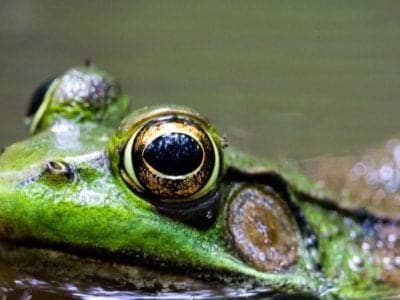
Pool Frog
The rarest amphibian in the UK!

Porcupine
There are 30 different species worldwide!

Purple Emperor Butterfly
Inhabits deciduous forests!
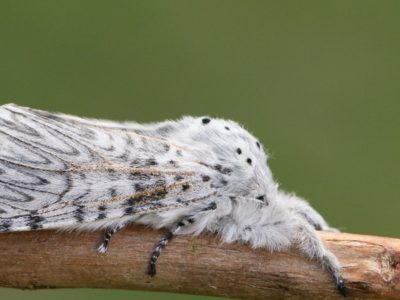
Puss Moth
Caterpillars squirt formic acid!

Quail
Inhabits woodland and forest areas worldwide!

Rabbit
There are more than 300 different species!
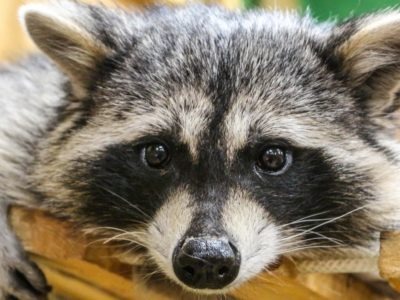
Raccoon
Known to wash their food before eating it!
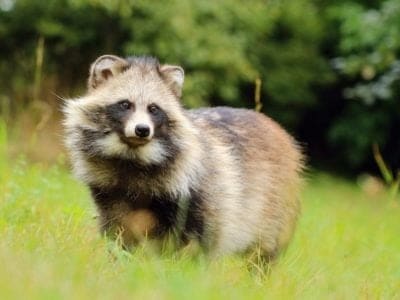
Raccoon Dog
The only hibernating canine!

Rat
Omnivores that eat anything!

Rat Snakes
Rat snakes are constrictors from the Colubridae family of snakes.

Red Deer
A male red deer shows his age in his antlers, which become longer and more branched every year.
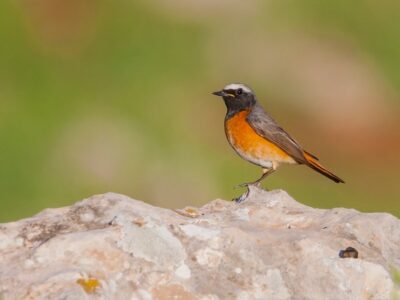
Redstart
They build their nests off the ground in tree holes, cavities, stone walls, and roofs

River Turtle
Inhabits freshwater habitats around the world!

Robin
There are more than 45 species in Australia alone!

Rodents
The capybara, the world’s largest rodent, likes to be in and around bodies of water. Because of this, the Catholic Church in South America decided that it was a fish, and people were allowed to eat it during Lent and First Fridays.
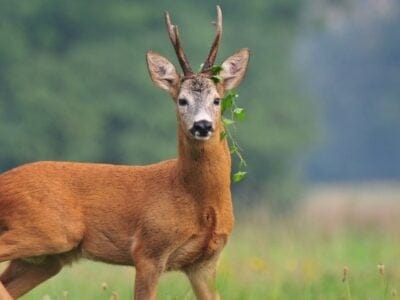
Roe Deer
The roe is one of the most popular game animals in Europe

Rooster
Will mate with the entire flock!
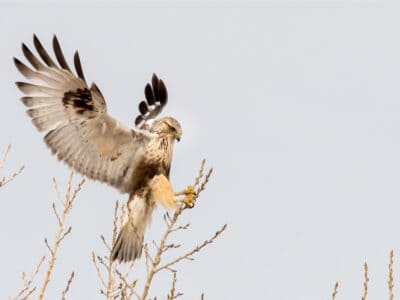
Rough-Legged Hawk (Rough-Legged Buzzard)
Its scientific name, lagopus, is Ancient Greek for “hare” and “foot,” referring to its feathered feet and toes.
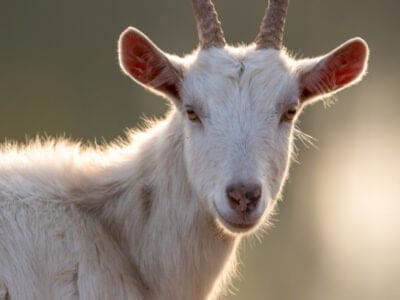
Saanen Goat
The saanen goat is the most popular milk breed.

Sable Ferret
Ferrets were used during the Revolutionary War to keep down the rat population.

Saint Bernard
Gentle, loyal and friendly!

Salamander
There are more than 700 different species!
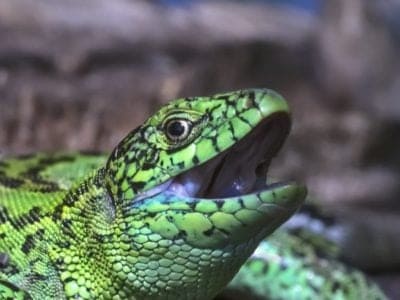
Sand Lizard
Males turn green in spring!

Scorpion
There are around 2,000 known species!

Sea Eagle
The sea eagle tends to mate for life with a single partner

Seahorse
Males give birth to up to 1,000 offspring!

Sheep
Around 35 million in the English countryside!

Short-Eared Owl
The short-eared owl is one of the most widespread owl species in the world, covering five continents.

Shrew
The spinal column of the shrew Scutisorex somereni is so strong and reinforced that it can support the weight of an adult human.

Shrimp
There are 2,000 different species worldwide!

Skink Lizard
Some skinks lay eggs in some habitats while giving birth to skinklets in other habitats.

Slow Worm
Found widely throughout British gardens!

Slug
They glide around on one foot, which is aided by the slime they produce

Smokybrown Cockroach
Has up to 45 eggs per egg case

Snail
There are nearly 1,000 different species!

Snake
There are around 4,000 known species worldwide

Snowy Owl
One of the largest owl species in the world!
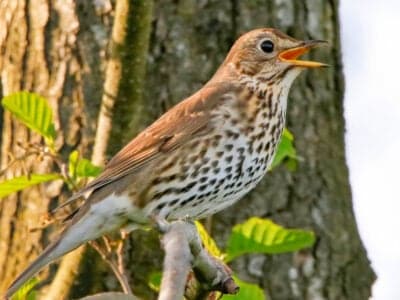
Song Thrush
A male song thrush can have over 100 phrases in his repertoire of songs and can imitate pet birds, telephones and other man-made objects.

Spadefoot Toad
They spend most of their time underground!

Sparrow
There are 140 different species!

Spider Wasp
They prey on spiders to feed their larvae or they parasitize other spider wasps.

Squirrel
Small rodents found in woodlands worldwide!

Stick Insect
There are more than 3,000 different species!

Stoat
Average adults weigh about 200 grams!

Stork
They can’t sing like other birds.

Swan
Populations have been affected by pollution!
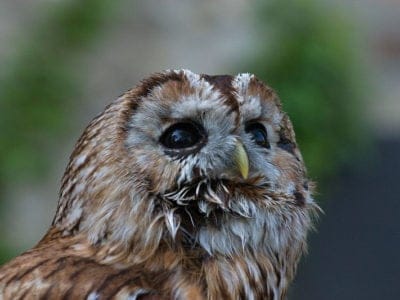
Tawny Owl
The most widespread owl in Europe!

Termite
Their mounds can be up to 9 meters tall!

Thrush
The American robin is called the robin because its red breast reminded European settlers of the robin back in the old country.

Tick
They inject hosts with a chemical that stops them from feeling the pain of the bite

Tiger Beetle
The adult tiger beetle is one of the fastest land insects in the world
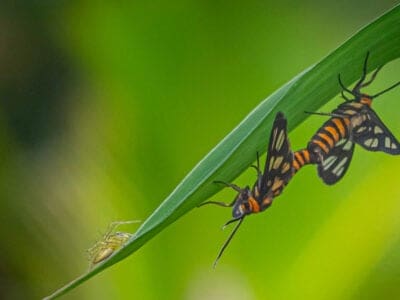
Tiger Moth
The bright colors of this moth are a signal to predators that it has a terrible taste.

Tortoise
Can live until they are more than 150 years old!

Tree Frog
Found in warmer jungles and forests!

Turtles
Some species of aquatic turtles can get up to 70 percent of their oxygen through their butt.

Viper
Vipers are one of the most widespread groups of snakes and inhabit most

Vulture
There are 30 different species worldwide!

Wasp
There are around 75,000 recognised species!

Water Buffalo
Has been domesticated for thousands of years!
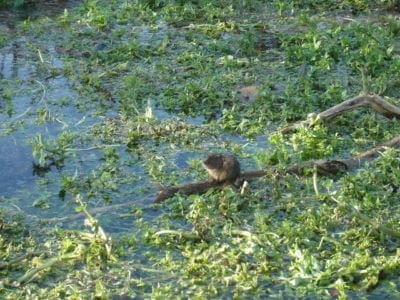
Water Vole
The largest Vole species in the UK!

Wax Moth
The Wax Moth larvae are more dangerous than the adult.

Weasel
The smallest carnivorous mammal in the world!

White Ferret / Albino Ferrets
There are two different types of white ferrets!
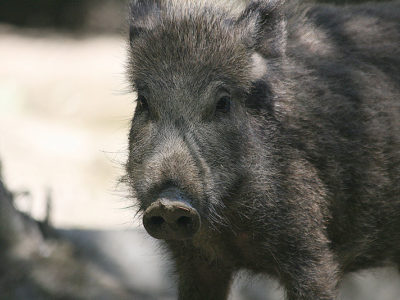
Wild Boar
Males have a top tusk to sharpen the bottom one!

Wolf
Thought to date back more than 300,000 years!

Wolf Spider
Carnivorous arachnid that hunts its prey.

Woodlouse
This animal can roll up into a ball

Woodlouse Spider
Unlike most spiders, woodlouse spiders don’t build a web.

Woodpecker
There are 200 different species!
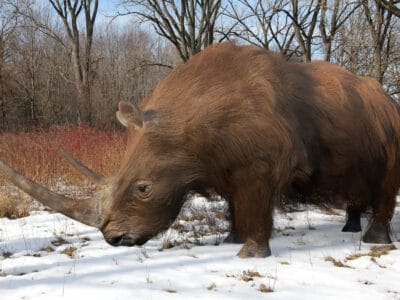
Woolly Rhinoceros
The woolly rhinoceros roamed the earth between three and a half million and 14,000 years ago.

Worm
Doesn’t have eyes.

Wryneck
They feign death by making their bodies limp and closing their eyes.
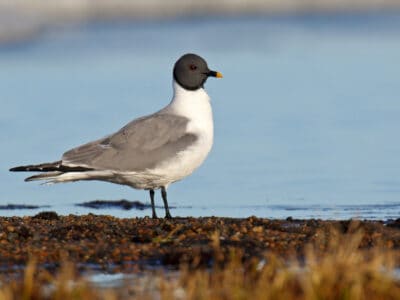
Xeme (Sabine’s Gull)
They follow after seals and whales to eat their scraps.

Yellowhammer
It interbreeds with the pine bunting
Swiss Animals List
- Admiral Butterfly
- Ant
- Apennine Wolf
- Appenzeller Dog
- Armyworm
- Asp
- Aurochs
- Avocet
- Badger
- Barn Owl
- Barn Swallow
- Bat
- Beaver
- Bed Bugs
- Bee
- Beetle
- Beewolf wasp
- Bernese Mountain Dog
- Bird
- Biscuit Beetle
- Black Widow Spider
- Blackpoll Warbler
- Brown-banded Cockroach
- Brown Dog Tick
- Bumblebee
- Butterfly
- Camel Cricket
- Carpenter Ant
- Cat
- Caterpillar
- Catfish
- Centipede
- Ceratosaurus
- Chamois
- Chicken
- Cicada
- Cockroach
- Codling Moth
- Common Buzzard
- Common European Adder
- Common Frog
- Common Furniture Beetle
- Common House Spider
- Common Loon
- Common Raven
- Common Toad
- Cormorant
- Cow
- Crab
- Crab Spider
- Crane
- Cricket
- Crow
- Cuckoo
- Deer
- Devil’s Coach Horse Beetle
- Dog
- Dog Tick
- Donkey
- Dormouse
- Dragonfly
- Duck
- Dung Beetle
- Eagle
- Earthworm
- Earwig
- Edible Frog
- Eel
- Eider
- Entlebucher Mountain Dog
- Ermine
- Eurasian Bullfinch
- Eurasian Eagle-owl
- Eurasian Jay
- European Bee-Eater
- European Goldfinch
- European Robin
- Falcon
- Fallow deer
- False Widow Spider
- Ferret
- Fire-Bellied Toad
- Fire Salamander
- Firefly
- Flea
- Fleckvieh Cattle
- Fly
- Flying Squirrel
- Fox
- Frog
- Fruit Fly
- Gadwall
- German Cockroach
- German Wirehaired Pointer
- Glass Lizard
- Glowworm
- Gnat
- Goat
- Goldcrest
- Golden Eagle
- Golden Oriole
- Goose
- Grasshopper
- Greater Swiss Mountain Dog
- Gypsy Moth
- Hamster
- Hare
- Hawk Moth Caterpillar
- Hedgehog
- Heron
- Highland Cattle
- Honey Bee
- Honey Buzzard
- Hoopoe
- Horse
- Horsefly
- Housefly
- Human
- Huntsman Spider
- Ibex
- Insects
- Jackdaw
- Japanese Beetle
- Jumping Spider
- Kingfisher
- Ladybug
- Lazarus Lizard
- Leech
- Lemming
- Linnet
- Lizard
- Loach
- Locust
- Long-Eared Owl
- Long-Tailed Tit
- Magpie
- Marmot
- Marsh Frog
- Mayfly
- Mealybug
- Merganser
- Millipede
- Mole
- Mole Cricket
- Mongrel
- Moorhen
- Mosquito
- Moth
- Mouse
- Mule
- Natterjack
- Neanderthal
- Nematode
- Newt
- Nightingale
- No See Ums
- Northern Pintail
- Nut Weevil
- Old House Borer
- Orb Weaver
- Ortolan Bunting
- Osprey
- Otter
- Owl
- Pantaloon Bee
- Peppered Moth
- Peregrine Falcon
- Pheasant
- Pig
- Pigeon
- Pika
- Pike Fish
- Pine Marten
- Pond Skater
- Pool Frog
- Porcupine
- Purple Emperor Butterfly
- Puss Moth
- Quail
- Rabbit
- Raccoon
- Raccoon Dog
- Rat
- Rat Snakes
- Red Deer
- Redstart
- River Turtle
- Robin
- Rodents
- Roe Deer
- Rooster
- Rough-Legged Hawk (Rough-Legged Buzzard)
- Saanen Goat
- Sable Ferret
- Saint Bernard
- Salamander
- Sand Lizard
- Scorpion
- Sea Eagle
- Seahorse
- Sheep
- Short-Eared Owl
- Shrew
- Shrimp
- Skink Lizard
- Slow Worm
- Slug
- Smokybrown Cockroach
- Snail
- Snake
- Snowy Owl
- Song Thrush
- Spadefoot Toad
- Sparrow
- Spider Wasp
- Squirrel
- Stick Insect
- Stoat
- Stork
- Swallowtail Butterfly
- Swan
- Tawny Owl
- Termite
- Thrush
- Tick
- Tiger Beetle
- Tiger Moth
- Tortoise
- Tree Frog
- Turtles
- Viper
- Vulture
- Wasp
- Water Buffalo
- Water Vole
- Wax Moth
- Weasel
- White Ferret / Albino Ferrets
- Wild Boar
- Wolf
- Wolf Spider
- Woodlouse
- Woodlouse Spider
- Woodpecker
- Woolly Rhinoceros
- Worm
- Wryneck
- Xeme (Sabine’s Gull)
- Yellowhammer
Animals in Switzerland FAQs (Frequently Asked Questions)
What animals live in Switzerland?
The animals that call Switzerland home are typically those accustomed to cold conditions, rocky terrain, and high elevations. This is why so many birds, relatives of goats, small animals, and bears are found across the country. Those who are especially agile, have extra fur or fat, or possess the ability to burrow typically do best in this European country.
Are there wild animals in Switzerland?
Switzerland is home to a great deal of wildlife, much of which was introduced or migrated back over from other countries between the 19th and 21st centuries.
Does Switzerland have dangerous animals?
Switzerland does not have much dangerous wildlife in the traditional sense. The aspic viper, while venomous, is fatal, only if untreated, in about 4% of instances.
What animals live in the Swiss Alps?
Animals like the Alpine ibex and other relatives of goats are found along the rocky mountainsides. Birds like the bearded vulture, golden eagle, and barn owl are also common in these areas.








